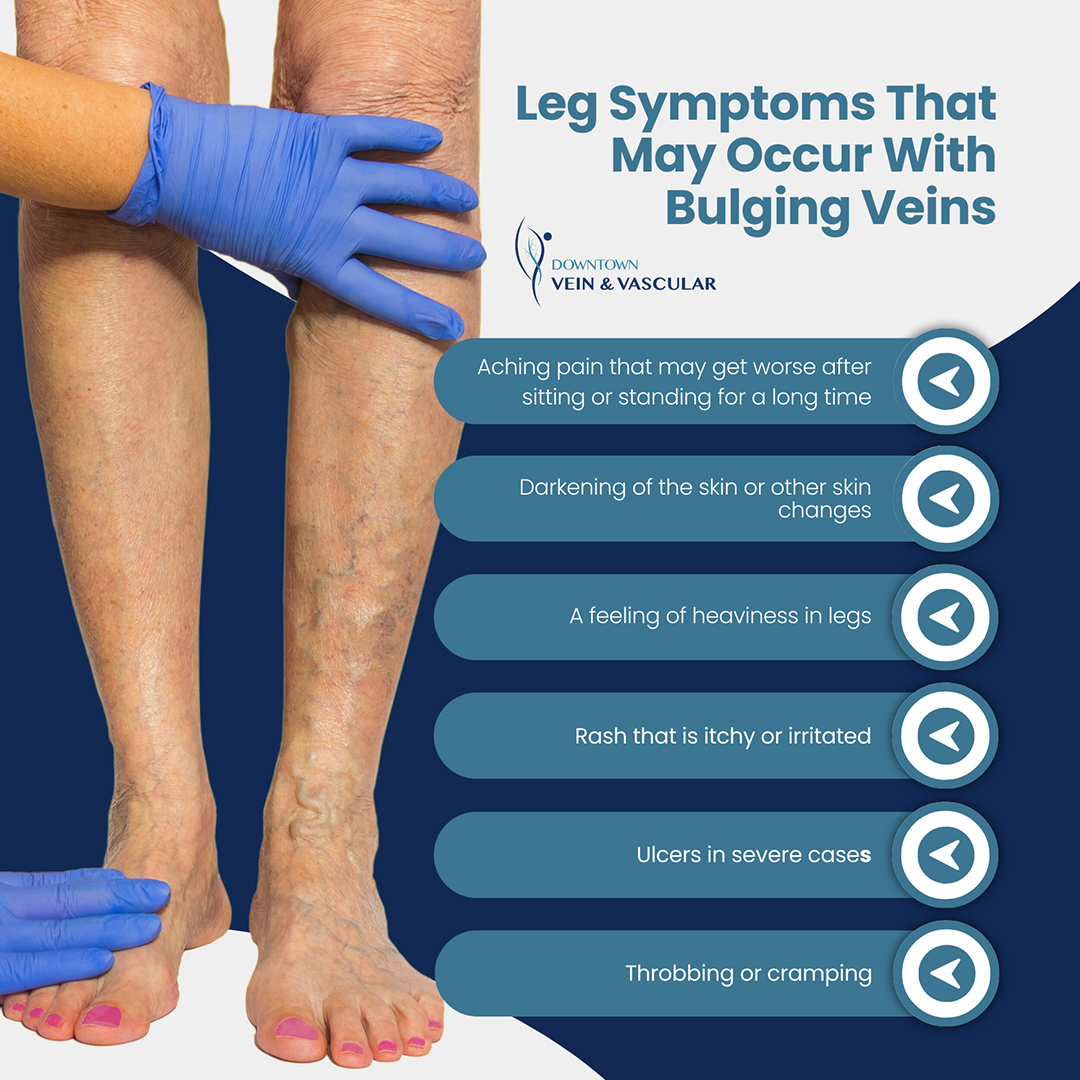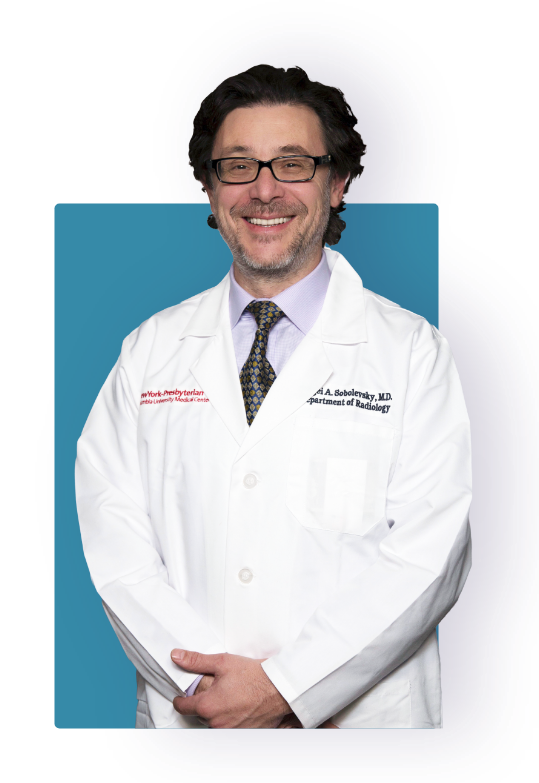Bulging veins on the feet are not a serious medical issue for a majority of people, but if you fear your popping veins are turning serious or you don’t like the way they look, visit Downtown Vein & Vascular Center. Dr. Sergei A. Sobolevsky uses state-of-the-art diagnostic technology to look inside your veins to determine if the valves are functioning correctly. He has the experience and expertise to diagnose and treat circulatory problems that result in abnormal lower leg symptoms. He recommends safe and effective treatments, customized to address your condition and makes you feel better.
What Are Bulging Veins?
Bulging veins are prominent, enlarged veins that are closer to the surface of the skin and often appear purple or blue. They are quite visible as they are superficial veins closer to the skin surface and usually show up in your legs, feet, and ankles. They seem to be popping out of the skin.
While bulging veins on the feet are harmless, many people do not like how they look. It could be due to more translucent skin that is showing veins easily, or it could be due to the large size of the veins. However, if they are very noticeable, grow bigger, appear twisted or rope-like, and cause pain or discomfort, they could be a sign of a more serious problem, such as a blood clot, or lead to other complications.
It is essential to know what causes your veins to bulge and if you should call your healthcare provider.
Read more: Artery vs. Vein: What’s the Difference?
What Causes Bulging Veins or Varicose Veins?
Bulging veins, at times also identified as varicose veins, are often accompanied by pain, discomfort, itching, and other symptoms. A varicose vein is a common condition that makes your veins seem bigger and closer to the surface of the skin. These symptoms and the unsightly appearance of veins can affect your quality of life and ability to function normally. It is essential to seek medical help to understand what is making your veins bulge out and how they can be treated or managed.
Since the veins work against gravity, veins in the legs have valves that act as one-way flaps to prevent blood from flowing backward as it moves up the legs. If these valves fail to function properly, blood drops backward towards your feet and begins to pool in the veins, which results in enlarged or bulging veins. It usually occurs in conditions affecting the vein itself or in association with other conditions such as pregnancy and aging.
Other common causes of bulging veins include:
- Inflammation and swelling of a vein, known as thrombophlebitis
- Obesity
- Lack of movement or a sedentary lifestyle
- Obstructions to the flow of blood in veins, such as a blood clot
- Injury to the vein
- Vein damage
- Hormones
- Family history of venous issues
When the valves are unable to function, the blood pools in the veins and increases venous pressure, causing them to stretch, twist, and bulge out. This condition is also known as varicose veins.

Leg Symptoms That May Occur With Bulging Veins
Bulging veins may also cause other leg symptoms. Some common signs and symptoms of varicose veins include:
- Aching pain that may get worse after sitting or standing for a long time
- Darkening of the skin or other skin changes
- A feeling of heaviness in legs
- Rash that is itchy or irritated
- Swelling
- Throbbing or cramping
- Cramping
- Restless legs
- Burning
- Ulcers in severe cases
If you do not seek timely treatment, varicose veins, and their symptoms worsen. In some cases, bulging of veins can also be a warning sign of some underlying health condition. Call your doctor if you experience bulging veins along with skin ulcers, sudden swelling in the feet, trouble breathing, or chest pain as they could be symptoms of peripheral vascular disease and blood clots. Also, if your bulging veins are persistent or cause severe pain, seek immediate medical care.

Why Are the Varicose Veins in My Feet Bulging So Much?
Veins often become more prominent on the hands or feet as we grow old. We lose collagen as we age, and hands and feet lack the more robust soft tissues that support and hide veins in the other parts of the body. In some cases, bulging can also result from problems with increased pressure in these veins.
You can expect veins to bulge out in the following circumstances naturally:
- If your skin is thinning due to aging
- Low body fat if you are trying to reduce weight
- Increased blood pressure due to intense physical activity
In these cases, vein bulging is harmless and does not indicate a critical medical issue. It is important to note that the venous blood flow closest to the heart will be under the least amount of pressure while the venous blood flow at the level of the feet will be under most stress. Try lying on your back with the legs up, and you will see the bulging veins disappearing. This is because you have relieved their pressure.
Read more: What Are Dark Spots on the Bottom or Top of Feet?
Are All Bulging Veins Varicose Veins?
Not all bulging veins are varicose veins, and they are generally harmless. If your popped-out veins are causing pain, discomfort, or any other symptoms, it may be a sign of untreated varicose veins.
Read more: Can I have a baby if I have fibroids?
Treatment for Bulging Veins in Your Feet
Bulging varicose veins do not go away on their own, but there are home remedies and lifestyle changes to ease discomfort and make your veins less visible.
Common treatments for bulging veins include:
- Wearing compression stockings
- Elevating your legs several times every day to soothe the veins and calm any discomfort
- Avoiding standing or sitting for extended periods
- Perform exercises that contract your legs muscles, such as calf raises, squats, or lunges
- Take 15 to 30-minute walks two to three times per day
- Wear less constricting shoes to promote full flexion of your foot when walking
If these home remedies are not working and you notice new bulging veins, it is time to see a vein doctor. The specialist will feel your veins and may suggest an ultrasound to check for blood clots and recommend the best treatment to close the damaged or faulty veins.
Medical treatments for varicose veins include:
- Sclerotherapy – The doctor injects a chemical solution into targeted veins that scars and closes these veins. The treated veins fade in a few weeks.
- Endovenous ablation – The specialist uses laser energy to cauterize and close varicose veins.
- Ambulatory phlebectomy – During this procedure, the doctor makes an incision, ties off the vein, and removes it. The blood in this vein is automatically shifted, and the closed vein eventually fades away.
These minimally invasive vein treatments are safe and effective and help to reduce pain and improve the appearance of varicose veins.
You don’t have to live with bulging veins on your feet. While bulging veins may be a sign of varicose veins, your veins may appear more prominent on the feet due to several other reasons. Dr. Sergei A. Sobolevsky at Downtown Vein & Vascular Center diagnoses the causes behind your popping veins and comes up with the best solutions to manage them. He examines your bulging veins to determine the source and severity of your condition. Dr. Sobolevsky is a board certified endovascular specialist. He suggests the best procedures to reduce pain and swelling and ensures you are back to your normal routine within the shortest possible time.

Sergei Sobolevsky, MD, is a leading specialist in endovascular medicine with experience in vascular and interventional radiology. Dr. Sobolevsky has decades of experience in the field, with over 25,000 procedures performed, accumulating extensive experience in image-guided minimally invasive medicine, diagnosing and treating a range of conditions.
Dr. Sobolevsky earned his Doctor of Medicine (MD) degree in 1997 from the University of Colorado School of Medicine. He received his specialty clinical training in vascular and interventional radiology at Harvard University. Later, he earned his MBA from the MIT Sloan School of Management. Recognized as a Castle Connolly Top Doctor and named to the Top Doctors New York Metro Area in 2020, 2021, and 2022, Dr. Sobolevsky is licensed in multiple states, has delivered presentations at numerous institutions in the US and abroad, and now acts as a clinical advisor for the biomedical industry. He also held multiple positions in the field during his career, including Chief of Vascular and Interventional Radiology at the Columbia University Medical Center in New York, NY, Senior Vice President in Clinical and Regulatory Affairs at Artann Laboratories in North Brunswick, NJ, and Medical Director at the American Endovascular and Amputation Prevention Center in Brooklyn.
More About Dr. Sobolevsky
